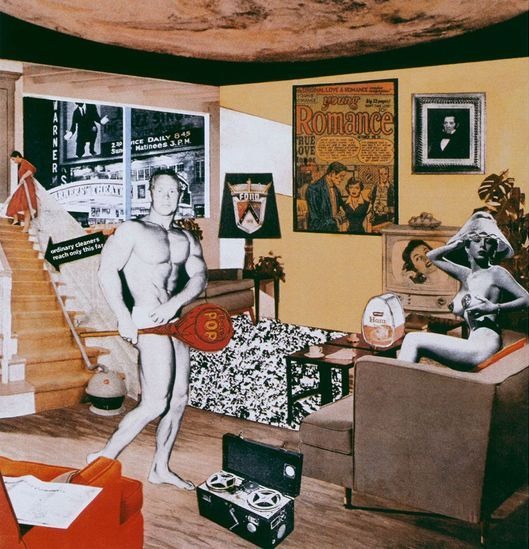Richard Hamilton's "Just what is it that makes today's homes so different, so appealing?"
Richard Hamilton uses popular images and symbols as fodder to explore an interior realm and to comment on the rapid and fundamental change of everyday existence. Just what is it that makes today’s homes so different, so appealing? is iconographic because it was created during a time in which people all over the world became mall shoppers, television watchers, car drivers, and throwaway buyers. Simultaneously, the boundaries of old world civilizations and of international politics were consumed by capitalism; some countries chose to adopt the trappings of that economic system without embracing its basic values of competition, efficiency, legitimacy of profit, all of which ultimately make the consumerist structure function and flourish properly.
The perversion of Western ideas of effective business conduct is translated in this 1956 collage by the plethora of items acquired through conspicuous consumption. They are shown as a symbol of leisure. And the viewer is reminded of how speedily the public forgets about the consequences of irresponsible expenditure, since the “buy, buy, buy” lifestyle continues at an ever faster rate, even after the world’s nations were cast askew as a result of the economic catastrophes of 1929. This can be seen through the technological advancements that are infiltrating this warped interior, with the presence of the television playing an ad of a woman speaking on the telephone, the obscure box-like recording device on the floor, the glitz and glamour related to the theater beyond the living room window, and the Ford hood ornament adorned on the lampshade.
Aside from the financially related historical subject matter, Hamilton also identifies the specter of Communism as the planet that doubles as the household’s ceiling. This Mars-like crescent is unassumingly present, hovering over and haunting the American family with the ambiguous signifier of all that was alien during the 1950s: communism. This reference to outer space brings attention to the informal “Space Race” between Russia and America, a critical ideological rivalry that would declare the more accomplished country to be the symbolic leader of the world. The morale-boosting societal benefits and potential propitious military advancements a space-related victory allowed for such a proposition.
The iconography of modernity, material comfort, and desirability present in Hamilton’s labor has opened the possibilities of Pop Art by assuring an idyllic realm of the upcoming buyer’s paradise, while relaying a doubtful and ironic tone - pronouncing the mode of sheer parody. This piece therefore becomes not only a visually creative playing field, but also a historical milestone in the world of art and in the context of societal criticism.


